COLORADO SPRINGS, COLO. —Think of Colorado and you think of mountains, and in a broadcast sense this presents challenges. As a broadcaster, you learn to work within the confines of what’s possible based on the rugged terrain and inhospitable weather conditions encountered.

MOUNTAINTOP CHALLENGES
One such example is how we transport STL audio from KCME(FM)’s studio in Colorado Springs to three remote mountaintop locations. These include Breckenridge in Summit County, Methodist Mountain above Salida, and Cripple Creek. KCME has an “all-classical” radio format, so we need to achieve great quality audio. None of these sites has wired network available; previously we used an expensive high-bandwidth satellite receiver to transport audio to each transmitter site. At around $17,000 per year, this was prohibitively expensive for a member-supported station. Plus, the connections experienced frequent dropouts due to poor weather conditions.
I first started using Tieline codecs years ago at Citadel Communications (now Cumulus Colorado Springs), and I have broadcast with them in just about every way imaginable; they are versatile and reliable. For KCME, I believed we could improve our results by installing Tielines, so in 2016 we purchased a six-input Tieline Genie Distribution codec with WheatNet-IP and installed it at KCME in Colorado Springs. We also installed a Tieline Bridge-IT XTRA codec at each remote transmitter site. To transport the audio we are using satellite IP data service attached to the codecs at Salida and Cripple Creek. Breckenridge uses a different service provided by the owners of the translator site on Mount Baldi, in Summit County, and is maintained by engineer Gary Peterson.
This has been a complete transformation for us. The connections are so much more reliable. We are not bothered too much about latency, so have employed conservative fixed jitter strategies with remarkable results. Our bandwidth is limited, so we connect using HE-AAC v2 at 64 kbps and the audio sounds much better than before. Lots of listeners have called and written to us to remark about how much better the station sounds which is extremely pleasing.

The other benefit is the cost savings. With lower bandwidth satellite links, we now save significantly on data costs, in fact we recouped the cost of the codecs in less than a year. The ongoing savings are also huge.
The codecs have to be reliable because we are unable to get to the mountaintop transmitter sites for around three months out of the year due to the weather conditions. They haven’t missed a beat and we can remotely log-in to the codecs using the Toolbox web browser configuration tool to effect any configuration changes.
The studios for KILO(FM) and KRXP(FM) are at the foot of Pikes Peak, the most visited mountain in North America and reaching 14,000 feet above sea level. Our transmitter for KILO and KRXP is situated at the top of Cheyenne Mountain and we feed audio to the transmitter over multiple paths.
REPORT-IT FOR TEMPORARY STLS
When I speak of versatility, I have to mention that I once ran a station for around four hours using Tieline’s Report-IT Enterprise smartphone app while I performed some transmitter site servicing tasks. To achieve this, I fed audio from the studio down the return path of a Report-IT smartphone connection and fed this into a Matchbox D.I. box and then into the transmitter. It worked solidly and proved to me that with a bit of lateral thinking, anything is possible in the world of broadcast.
We use a Moseley 900 MHz STL encoder to feed linear audio directly up the mountain to a Moseley decoder for both stations. As a backup, we use a Genie Distribution codec at the studio to stream two stereo feeds over a 5.8 GHz Ubiquiti link to a Genie Distribution codec top side. Inputs 5 and 6 of the Genie Distribution top side are used to feed an older Marti RF transmitter, which is used to bring audio down as a remote broadcast backup for each station. There is also a transmitter for KCME on Cheyenne Mountain. We use a Moseley Starlink 900 MHz STL for the primary HD system into a BE FMi703 transmitter.
As a sidenote, Pikes Peak is not too far from Summit House, the purveyor of world-famous Pikes Peak doughnuts. So if time allows, it is definitely worth the trip!
For information, contact Dawn Shewmaker at Tieline USA in Indiana at (317) 845-8000 or visit www.tieline.com.











